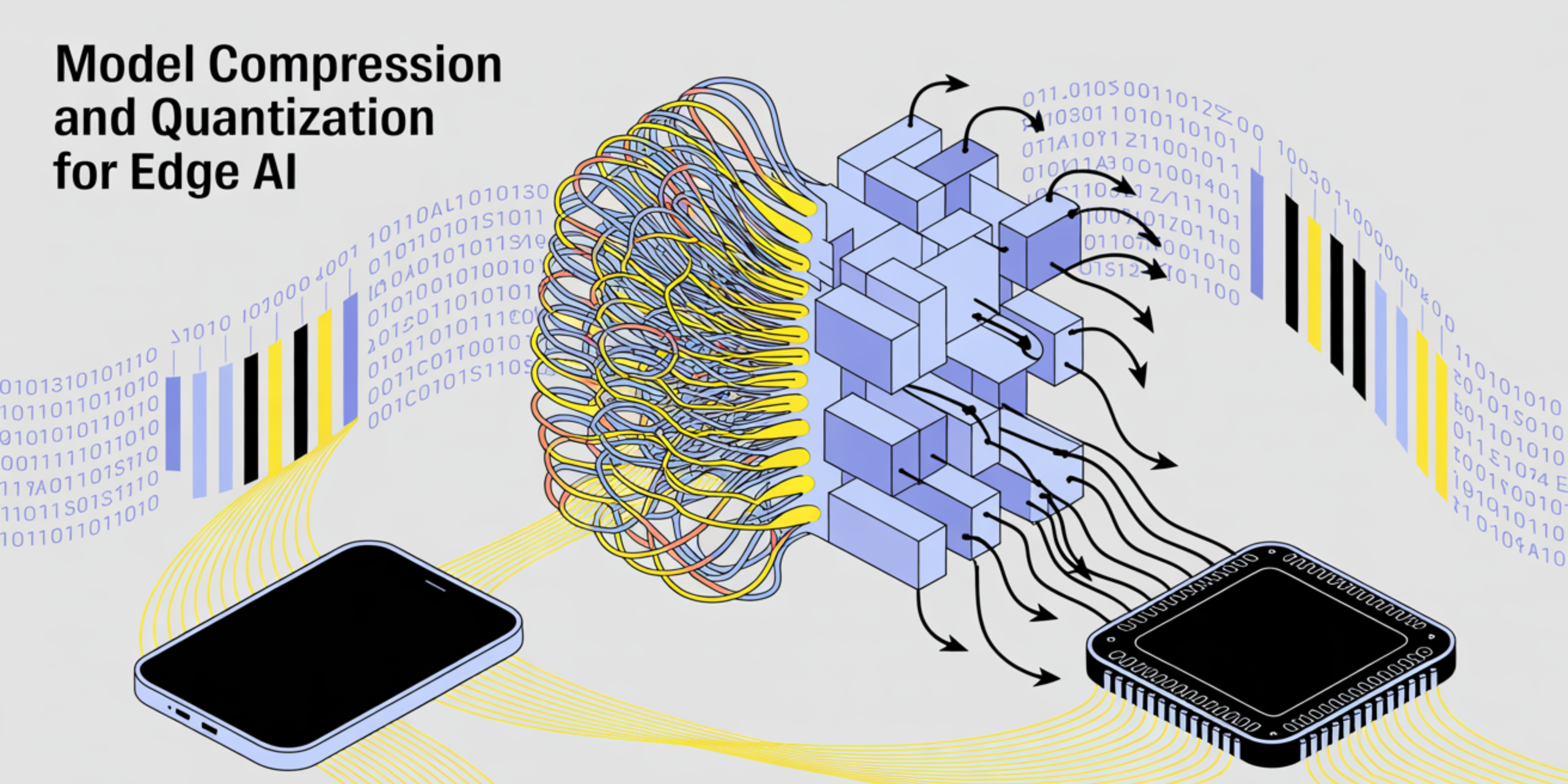Artificial intelligence advancement continues transforming industries worldwide. Consequently, businesses increasingly deploy sophisticated machine learning models directly on edge devices. However, traditional AI models demand substantial computational resources. Therefore, organizations need effective model compression and quantization for edge AI to bridge the gap between powerful algorithms and resource-constrained hardware. This need is especially evident in mobile and edge device optimization, where power, memory, and processing limitations are critical factors.
Key Points:
- Edge AI brings intelligence closer to data sources while reducing latency
- Resource-constrained hardware requires specialized optimization techniques
- Model compression enables real-time AI on smartphones, IoT sensors, and autonomous vehicles
Understanding Edge AI Deployment Challenges
Edge AI deployment presents unique obstacles that cloud-based systems rarely encounter. Specifically, computational limitations significantly impact model performance since edge processors operate with reduced processing power compared to cloud infrastructure. Power consumption represents another critical consideration, particularly for battery-powered applications requiring extended operational periods.
Key Challenges:
- Limited processing power and memory capacity on edge devices
- Stringent energy constraints for battery-powered applications
- Network connectivity issues with intermittent internet access
- Traditional models contain millions of parameters requiring substantial resources
Pruning: Strategic Parameter Elimination
Pruning emerges as one of the most effective approaches to model compression and quantization for edge AI applications. This technique operates on the principle that neural networks contain redundant parameters contributing minimally to overall performance. The pruning process follows a methodical approach that begins with training a complete model to convergence.
Pruning Benefits:
- Systematically removes unnecessary connections, neurons, or layers
- Modern gradual pruning strategies remove parameters incrementally during training
- Yields superior results compared to aggressive one-time pruning
- Dynamic strategies adapt removal criteria based on training progress
- Supported by deep learning compiler stack tools for efficient transformation
Quantization: Precision Optimization for Enhanced Efficiency
Quantization addresses model compression through reducing numerical precision requirements. Traditional deep learning models utilize 32-bit floating-point representations for weights and activations. However, quantization techniques successfully reduce this precision to 16-bit, 8-bit, or lower representations while maintaining acceptable accuracy levels.
Quantization Methods:
- Post-training quantization: Applies compression without requiring original training datasets
- Quantization-aware training: Integrates quantization directly into training procedures
- Dynamic quantization: Balances optimization by quantizing weights while maintaining higher precision activations
- Static quantization: Achieves maximum efficiency by quantizing both weights and activations
- Supports ARM processor optimization via low-precision instruction sets
Knowledge Distillation: Advanced Learning Transfer
Knowledge distillation represents an innovative approach to model compression that transfers expertise from large, complex models to smaller, efficient alternatives. The distillation process involves simultaneous training of two distinct models. A large teacher model achieves superior accuracy on target tasks through extensive training.
Distillation Techniques:
- Response-based distillation: Matches final output patterns between teacher and student models
- Feature-based distillation: Matches intermediate network representations at various processing layers
- Temperature parameters in softmax functions produce softer probability distributions
- Balanced loss functions combine traditional task objectives with distillation losses
- Often used in mobile deployment framework such as TensorFlow Lite and PyTorch Mobile
Combining Techniques for Maximum Optimization
Successful edge AI deployments frequently combine multiple model compression techniques to achieve optimal performance results. Progressive compression applies different optimization methods sequentially, beginning with pruning to eliminate unnecessary parameters. Joint optimization approaches simultaneously implement multiple compression techniques throughout training processes.
Optimization Strategies:
- Sequential application: Pruning followed by quantization and knowledge distillation
- Joint optimization: Multiple techniques applied simultaneously during training
- Technique selection depends on specific deployment scenario requirements
- Applications demanding maximum compression prioritize aggressive quantization with extensive pruning
- Tools like Intel’s edge AI toolkit, PyTorch Mobile, and TensorFlow Lite support hybrid techniques
Performance Evaluation and Implementation
Evaluating compressed models requires analyzing multiple performance metrics beyond traditional accuracy measurements. Inference latency determines how rapidly models process input data, which becomes critical for real-time applications. Energy consumption assumes particular importance for battery-powered edge devices where efficient models significantly extend operational duration.
Evaluation Metrics:
- Inference latency for real-time application requirements
- Memory footprint including static model size and runtime requirements
- Energy consumption for battery-powered devices
- Comprehensive benchmarking under realistic operational conditions
- Compatibility with hardware acceleration such as GPU inference optimization
- Benchmarking using tools in the deep learning compiler stack like TVM or XLA
FAQs:
- What distinguishes model compression from quantization in edge AI applications?
Model compression serves as a comprehensive umbrella term encompassing various techniques for reducing model complexity. Meanwhile, quantization specifically targets numerical precision reduction of weights and activations. Consequently, quantization represents one specialized type of model compression alongside pruning and knowledge distillation. - How significantly can pruning reduce model size while maintaining accuracy?
Pruning techniques typically achieve 50-90% parameter reduction while preserving acceptable performance standards. However, exact compression ratios depend on original model architecture complexity and specific task requirements. Furthermore, gradual pruning combined with fine-tuning generally produces superior results. - Which quantization approach provides optimal results for edge AI deployment?
Post-training quantization offers rapid implementation for immediate edge AI applications. Nevertheless, quantization-aware training typically delivers superior accuracy preservation. Additionally, 8-bit quantization frequently provides an ideal balance between model size reduction and performance maintenance. - Can multiple compression techniques combine effectively for enhanced performance?
Absolutely, combining techniques frequently yields superior optimization results for edge AI applications. Sequential application of pruning followed by quantization often outperforms individual technique implementation. Furthermore, joint optimization during training can achieve better compression ratios while maintaining accuracy. - What hardware factors influence compression technique selection?
Different edge processors support varying optimization approaches. ARM processors excel with quantized models due to specialized low-precision instruction sets. Similarly, dedicated AI accelerators may require specific model structures for optimal performance achievement.
Stay updated with our latest articles on fxis.ai

